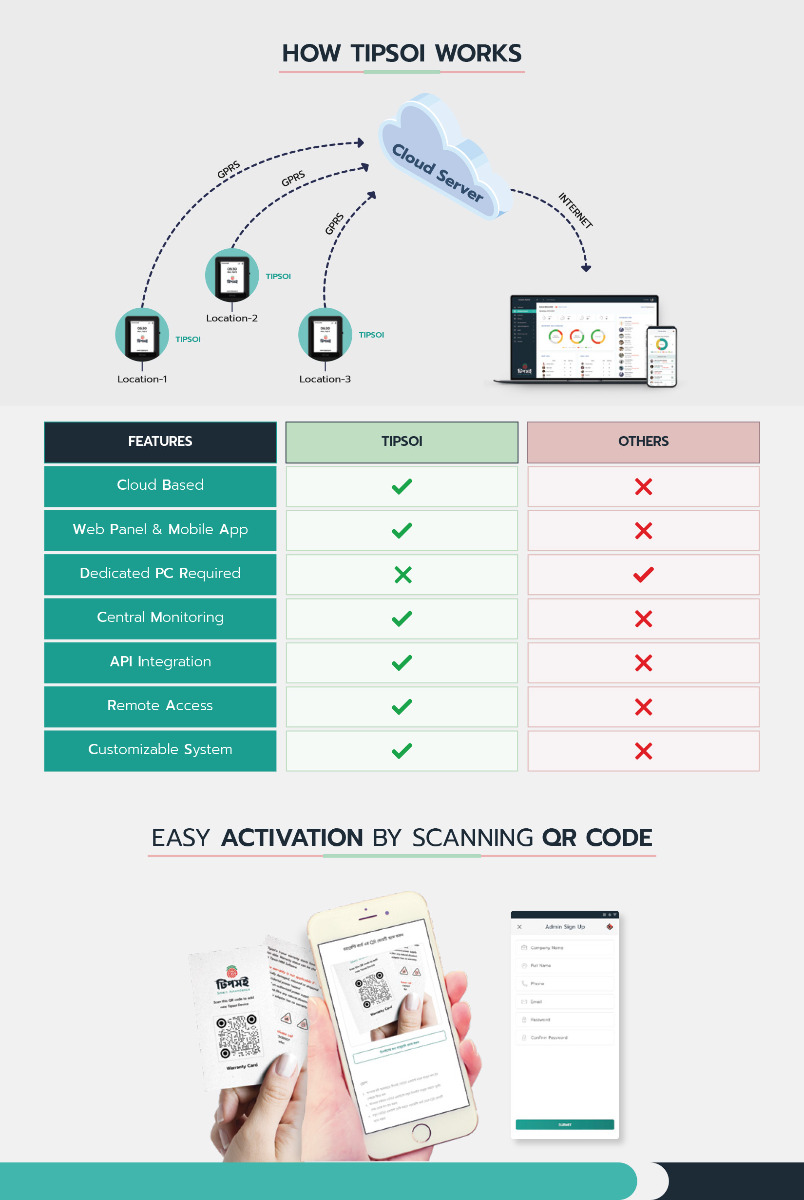Tipsoi Facial Recognition Attendance Management System Price in Bangladesh:
TIPSOI FACE SMART TIME ATTENDENCE
Tipsoi Face is a smart, hassle free, standalone cloud based facial recognition attendance management system. Coupled with a robust HR management software, it comes as a complete package which can provide the edge an organization needs.
Tipsoi Face D-920:
- Face storage Capacity: 50,000
- Log Capacity: 10,00,000
- Resolution: 1920*1080
- 8" LED Display
- Communication: LAN
- Voice Broadcast
- No-Mask Detection
- Easy Enrollment
- Web and Mobile Apps
EASY ENROLLMENT: Tipsoi Face Enrollment is very easy. Upload your picture in Tipsoi HRM profile and it will automatically complete enrollment for Tipsoi Face Recognetion Access Control.
Tipsoi Time Attendance HRM Software:
- Central monitoring from multiple location.
- Easy Enrollment, Easy Allocation.
- Remote Access from anywhere.
- Realtime Attendance Dashboard.
- Detailed Graphical Reports.
- Shift & Rostering Management.
- Advanced Leave Management.
- Overtime Management.
- GEO Location Based Attendance.

Smart Time Attendance Machine System Using Face Recognition:
Maintaining an attendance record while engaging in day-to-day activities is a difficult task. The traditional approach of calling each student's name takes time, and there is always the possibility of proxy attendance. The following system uses facial recognition to keep track of students' attendance. The daily attendance of pupils is kept track of each subject and is already saved by the administrator. When the time for the associated topic arrives, the system begins capturing photos and then applies a face detection and identification approach to the image, marking the recognized students as present and updating their attendance with the corresponding time and subject id. We developed this system using deep learning approaches; the histogram of oriented gradient method is used to detect faces in photos, and deep learning is used to compute and compare feature facials of students in order to recognize them. In real time, our technology can recognize many faces.
Every company wants a reliable and consistent method for keeping track of its pupils' attendance. Each organization has their unique way for doing so; some use a sheet of paper to take attendance by calling their names during lecture hours, while others use biometrics such as fingerprints, RFID card readers, and Iris systems to mark attendance. The traditional practice of manually calling pupils' names is a time-consuming event. Each student is assigned a card with their associated identity under the RFID card system, but there is a risk of card loss or unauthorized use of the card for fraudulent attendance. Other biometrics, such as finger print, iris, or voice recognition, all have limitations and are not 100% accurate.
The use of facial recognition for attendance marking is a sensible approach of implementing an attendance management system. Face recognition, among other techniques, is more precise and faster, and it decreases the risk of proxy attendance. Face recognition allows for passive identification, which means that the individual being recognized does not have to take any action in order to be identified.
Face recognition consists of two steps: the first is the detection of faces, and the second is the identification of those detected face images against a database. Face detection and identification methods have been introduced in a variety of ways. Face recognition can be done in two ways: appearance-based, which covers the entire face, or feature-based, which includes geometric features such as the eyes, nose, eye brows, and cheeks.
With the help of machine learning, our system uses a face recognition approach to reduce the flaws of existing systems. It requires a good quality camera to capture the images of students, and the detection process is handled by Smart attendance management system is designed to solve the issues of existing manual systems. We employed the face recognition technique to track student attendance and improve the system. The method works well in a variety of stances and variations. This system will need to be enhanced in the future because it sometimes fails to recognize pupils from a distance. We also have some processing limitations, so working with a high-processing system could result in even better results.




